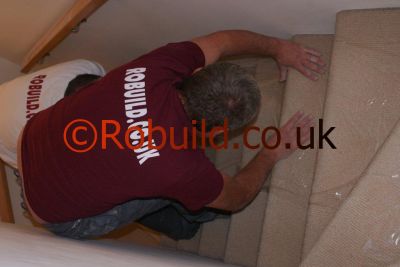
Reupholstering a padded armchair may seem a daunting task; but as long as you are familiar with the basic reupholstery techniques described and are prepared to take time and effort over the job, you should be able to tackle it successfully. Here we explain how to strip an armchair to its frame and replace each part of the upholstery. It may not be necessary, however, for you to strip the chair completely; if, for example, only the stuffing needs replacing, you can leave the layers underneath intact. Before you begin any work on the chair, it is important to make copious notes and clear diagrams of how and where each part of the final cover is fixed. Very few chairs are upholstered in exactly the same way and you may find some of our instructions will not apply to your particular chair; your notes and diagrams will ensure you replace everything correctly and retain the shape of the chair.
Stripping the chair
If the frame needs attention, you will have to strip the chair right down. Turn it upside down and place it on trestles or a firm table. Using a mallet and an upholsterer’s ripping chisel, remove the tacks which secure the bottom canvas. Turn the chair right side up and remove the outside back and outside arm covers; on some chairs these will be secured with tacks, but on others they will be slip stitched invisibly. Again, make notes and diagrams to ensure you can replace the covers correctly. Continue by stripping the seat; remove all tacks, including those holding the webbing, from the bottom frame of the chair and lift out the seat intact. Cut the twine holding the springs to the webbing and hessian, count the springs and note their size so you can replace them if necessary. Remove the seat cover and hessian from the stuffing by cutting the stitches; but leave the scrim in place so you do not disturb the shape. Remove the inside back and inside arm covers which are tacked to the outside of the back and arm frames. Also detach the scrolls, if any; these will be stitched on. If the chair has a calico inner cover, this will be tacked on and should be removed. Take out the tacks securing the scrim which holds the stuffing in place and lift off both the scrim and the stuffing without disturbing the shape. Finally remove the hessian.
Repairing the frame
Check the condition of the frame; you may have to get a carpenter to repair any loose joints and replaced damaged sections of timber. Check the frame has not been attacked by woodworm; treat with woodworm fluid if necessary and allow it to dry before continuing, otherwise the furnishing fabric may be spoiled. Fill any holes left by the original tacks with filler or plastic wood and rub smooth with abrasive paper.
Replacing the webbing
Turn the chair upside down and, using a web stretcher, hammer and l6mm improved (heavy) tacks, flt new webbing over the base of the chair seat in the same way as the original webbing. Turn the chair right side up and stretch two pieces of webbing vertically on the inside of each arm frame. On the inside back fix three vertical strips of webbing and weave two horizontal ones through them to support the back stuffing.
Replacing springs
Place the seat springs on the webbing in the same position as they were originally fixed. Keep the front ones well forward to take the strain of the front edge; the other springs should be placed slightly towards the centre of the seat to allow clearance at the arms and back for the stuffing. Working from the inside of the seat and using twine and a springing needle, secure the base of each spring to the webbing; make three over sewing stitches in three places, with a long stitch underneath connecting each set of three. Lash the springs with lay cord or sisal.
Inside back
If the chair has back springs, these should be placed at the junctions of the webbing and secured with oversewing stitches in the same way as the seat springs. There is no need to lash these back springs.









